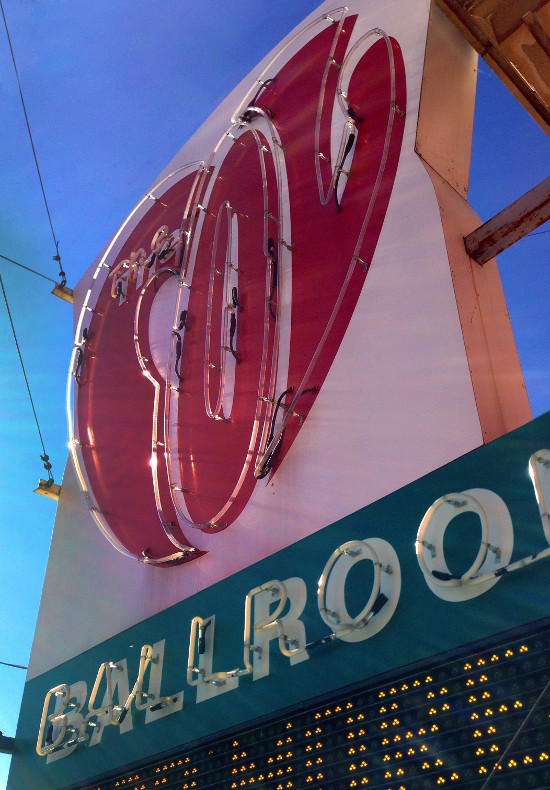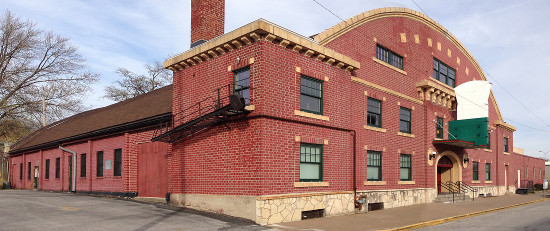
The Col Ballroom, at 1012 West Fourth Street in Davenport, is 100 years old this year. No other large ballroom in Iowa has reached a century of continuous operation. For that matter, neither has any ballroom in Chicago.
During the past century, the sign in front of the Col has been changed several times. The installation of a neon sign during the Jazz Age signaled a change in the cultural role of the ballroom. It was replaced when rock 'n' roll became king, re-made when rock went psychedelic, and duplicated when there wasn't a prevalent new direction in popular music.
Each sign had its own aesthetic, stylistically shaped by its era. Each is interesting in and of itself. However, they are all the more fascinating when we see them as a reflection of the sweep of changes in popular culture throughout the century.
In 1914, the Col's appearance reflected the desire to bring elevated culture and important speakers to the community. The ballroom's full name, Coliseum, was written in raised letters in stone over the entrance (and spelled with a "v" instead of a "u," as one would have seen in ancient Rome). The building's name and its architectural elements - the barrel-vaulted roof, the arched entrance, and the cornices and sconces that flanked the entrance - announced that this building was of great cultural importance to the community.
The ballroom opened its doors on October 27, 1914, with a performance by Ernestine Schumann-Heink, an internationally celebrated operatic contralto who performed with Gustav Mahler in London and was renowned in Germany for her renditions of Richard Wagner's operas. Other early appearances included senators, authors, oratorio singers, and Shakespeare interpretations.
 A decade later, the Roaring '20s were in full swing, replete with flappers and bootleggers. It was at this time that a large neon sign with the word "dance" across its top was installed on the building's exterior. The sign, especially at night, would have dominated the outward appearance of the ballroom - emphasizing innovation and excitement over the values expressed through the classical features of the building. Neon signs were first used in America in the '20s and were as new as jazz and the daring dances in vogue at this time - the Black Bottom, the Charleston, and the Shimmy, to name a few.
A decade later, the Roaring '20s were in full swing, replete with flappers and bootleggers. It was at this time that a large neon sign with the word "dance" across its top was installed on the building's exterior. The sign, especially at night, would have dominated the outward appearance of the ballroom - emphasizing innovation and excitement over the values expressed through the classical features of the building. Neon signs were first used in America in the '20s and were as new as jazz and the daring dances in vogue at this time - the Black Bottom, the Charleston, and the Shimmy, to name a few.
On March 4, 1924, King Oliver & his Creole Jazz Band played the Col to an overflow audience of 2,000 and returned for a second engagement a few days later because of overwhelming demand. The band took the stage at midnight and was, according to a newspaper account of the show, "so sensational ... that the people stopped dancing, crowded around the platform, and howled and stamped their feet for more." The band featured a young Louis Armstrong on trumpet. Also in 1924, George Gershwin performed Rhapsody in Blue on piano with Paul Whiteman & His Orchestra, shortly after the composition's famous premiere in New York.
Other popular stars who performed during this era included Duke Ellington, Frank Sinatra, Benny Goodman, Glenn Miller, and Count Basie. (See the sidebar for a list of notable Col performers through the years.) Frankie Trumbauer was playing at the Col with the Benson Orchestra when it is said that he first met Bix Beiderbecke. The two musicians would perform together in several orchestras, creating some of the most seminal jazz recordings.
In the late '50s, the Art Deco sign from the '20s was removed and replaced with a sign more stylistically in step with rock 'n' roll. The sign's prominent kidney-bean shape that enclosed the word "Col" was characteristic of the Doo-Wop style popular at the time. During this period, the ballroom began to feature a new wave of stars including Little Richard, Johnny Cash, Jerry Lee Lewis, Gene Vincent, and the Everly Brothers.
In 1968, the new sign was painted over with three red letters, "Col," in the shape of a heart. It reflected the new, psychedelic style introduced by bands such as the Jimi Hendrix Experience, which played at the Col on August 11, 1968. Another pioneering psychedelic rock band, The Yardbirds, played at the Col shortly before Jimmy Page left the band to form Led Zeppelin. In all, five of the top seven musicians on Rolling Stone's list of all-time greatest guitarists would perform at the Col: Hendrix, Page, Jeff Beck, B.B. King, and Chuck Berry.
The sign that is now over the Col's entrance was installed in 2007. The change was made so a digital screen could be added to the marquee, and because the old sign was badly weathered and needed to be replaced. For the first time, however, the new sign was a reproduction of its predecessor. After nearly four decades, the heart-shaped "Col" sign had become one of the most familiar - even iconic - images of Davenport, and there was resistance to changing it.
The decision to replicate the sign indicates that the ballroom's identity was no longer driven by a single direction in music. The range of performers in the past few decades has been diverse - from country singers such as Reba McEntire to metal groups such as Metallica; from rappers such as Trina and the Beastie Boys to alternative bands such as Sonic Youth and the Killers. Jazz is still performed live at the ballroom, and so is rock 'n' roll.
Extraordinarily, the whole sweep of the past century is still there to be seen. The classical elements, the neon technology introduced in the '20s, and the psychedelic-styled heart still grace the ballroom's façade. The new sign is a promise that the building's life will extend well into its second century.
Bruce Walters is a professor of art at Western Illinois University.
This is part of an occasional series on the history of public art in the Quad Cities. If there's a piece of public art that you'd like to learn more about, e-mail the location and a brief description to BD-Walters@wiu.edu.

Sidebar: Notable Performers at the Col
According to an October 14, 1914, article in the Rock Island Argus, the Coliseum was scheduled to open its doors on October 27, 1914. The scheduled performers were:
October 27: Ernestine Schumann-Heink (opera singer)
November 7: Reed Miller, Nevada Vander Veer, and Frederick Wheeler (oratorio singers)
November 12: Robert L. Owen (Oklahoma U.S. senator)
November 21: Frank J. Cannon (former Utah U.S. senator)
December 2: Opie Reed (author and humorist)
December 15: Dr. Hagerman (lecture)
December 21: Ben Greet Players
January 13, 1915: Bohumir Kryl and daughters
February 8: Rogers & Grilley (artists and songwriters)
March 2: Katherine Ridgeway concert company
March 12: Cathedral Choir
February 18: Montaville Flowers (Shakespeare interpreter)
The following lists were gathered from original Col Ballroom posters, concerts reviews, books on the performers, newspaper articles, and conversations with Don Wachel Jr., whose father owned and managed the Col Ballroom for 38 years.
1920s-'50s (jazz/popular)
Louis Armstrong
Count Basie
Benson Orchestra of Chicago, with Frankie Trumbauer (April 24-25, 1923)
Les Brown, with Doris Day
Tommy Dorsey, with Frank Sinatra
Duke Ellington
George Gershwin, with Paul Whiteman & His Orchestra and Ferde Grofé (May 23, 1924)
Benny Goodman
Woody Herman
Eddie Howard
Harry James
Stan Kenton
Wayne King
Guy Lombardo
Glenn Miller
Russ Morgan
King Oliver & his Creole Band, with Louis Armstrong (March 4, 1924)
Buddy Rich
Lawrence Welk
1950s-'60s (rock/R&B/popular)
The Beach Boys (July 30, 1963)
Box Tops
Chuck Berry
Johnny Cash (January 13, 1960; December 14, 1961)
Lou Christie
The Drifters
The Everly Brothers
The Fendermen
Jimi Hendrix Experience (August 11, 1968)
Brian Hyland (September 9, 1966)
Tommy James & the Shondells (April 2, 1967)
Jan & Dean (1964)
B.B. King
The Kingsmen
Gary Lewis & the Playboys (March 25, 1966)
Jerry Lee Lewis
Little Richard (1957)
Lee Michaels
The Moody Blues
New Colony Six (August 13, 1966)
Roy Orbison
Paul & Paula
Gene Pitney
Mitch Ryder & the Detroit Wheels (June 17, 1966)
Sam the Sham & the Pharaohs (November 2, 1966)
Soft Machine (Aug. 11, 1968)
The Turtles (November 7, 1967)
Vanilla Fudge
Bobby Vee
Bobby Vinton
The Yardbirds (August 5, 1966)
1970s-'80s
The Beastie Boys (March 1, 1987)
Blackfoot (May 1, 1983)
George Clinton (April 5, 1985)
Wayne Cochran
Enoch Smoky
Golden Earring (March 2, 1983)
Dave Edmunds (June 24, 1983)
Fishbone (March 1, 1987)
Foghat (July 31, 1986)
Lynn Allen Band (August 15, 1986)
Yngwie Malmsteen (December 5, 1986)
Reba McEntire
Metallica (May 3, 1986)
Oingo Boingo (May 1, 1986)
The Outfield (August 15, 1986)
Ratt (July 5, 1984)
Replacements
Leon Russell (1984)
Stray Cats (June 24, 1983)
Twisted Sister (September 4, 1984)
Stevie Ray Vaughan (October 4, 1985)
Muddy Waters (December 6, 1981)
Y&T (September 4, 1984; September 2, 1987)
W.A.S.P. (August 5, 1986)
Weird Al Yankovic (June 27, 1985)
1990s-present
311 (March 2000)
April Wine (July 20, 1993)
Blue Oyster Cult (November 29, 1993)
Clarence Gatemouth Brown (February 2, 1996)
Kevin Costner & Modern West (July 28, 2009)
Danzig (August 6, 1993)
Delbert McClinton (November 19, 2005)
Faith No More (September 22, 1992)
Freddy Jones Band (January 19, 1996)
Gin Blossoms (March 2, 1994)
Buddy Guy (June 3, 1993)
John Hiatt (March 1, 1994; January 29, 1996)
K's Choice (July 28, 1997)
The Killers with Tegan & Sara (May 9, 2005)
Marilyn Manson (October 4, 1996)
Megadeth (September 4, 1997)
Nazareth (November 29, 1993)
Pixies (January 24, 1992)
Reverend Horton Heat (July 12, 1996)
Slayer (August 5, 1994)
Slipknot (January 7, 2000)
Sonic Youth (October 1, 1992)
Tesla (March 3, 1995; July 3, 2001)
Trina (May 7, 2011)
Tripmaster Monkey (December 23, 1995)
Twista (March 3, 2011)
Uriah Heep (November 29, 1993)
The Verve Pipe (July 28, 1997)
Widespread Panic (August 3, 1995)
Wishbone Ash (November 29, 1993)










